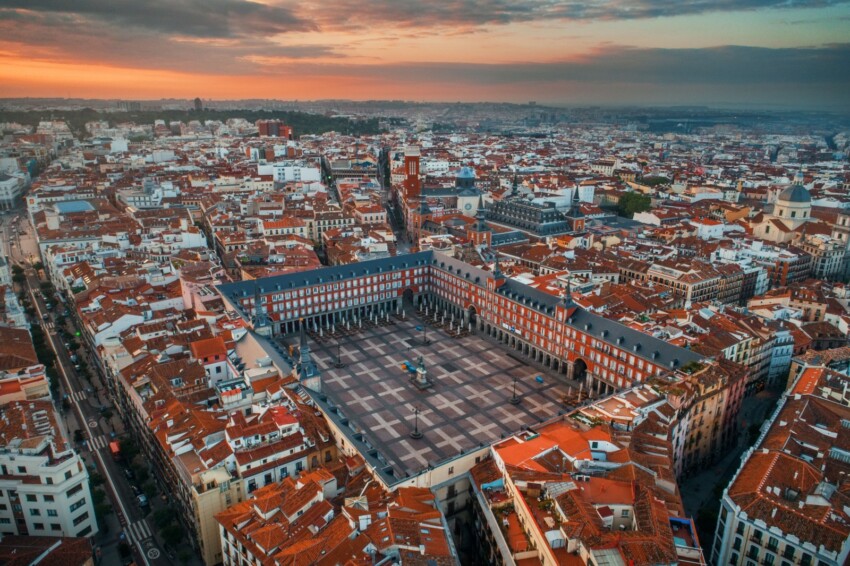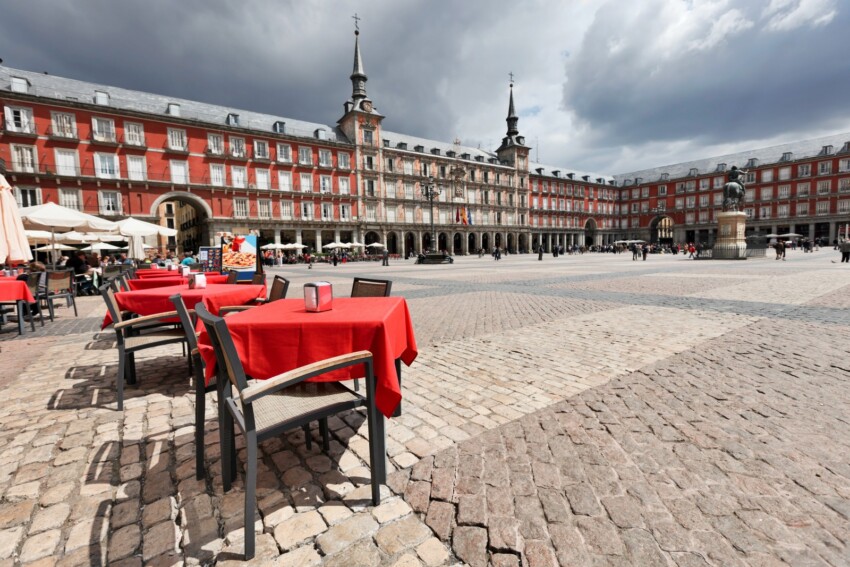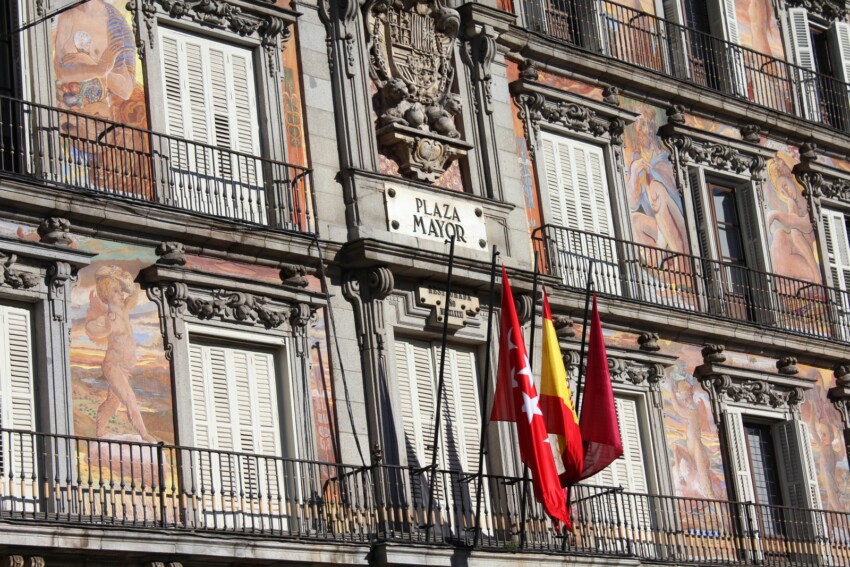

Among the squares of Madrid, a prominent role belongs to Plaza Mayor, in the heart of Austrias, the historical quarter of the city. Walking around the square or the neighbouring streets, it will be impossible not to notice the difference between this area, the old city characterised by alleys and narrow streets, and the conformation of modern Madrid, where wide avenues and open spaces prevail.
Baroque in style and rectangular in plan, the square is lined with elegant buildings, almost all occupied on the ground floor by shops, bars and restaurants and embellished by a row of arcades, and is enlivened by street artists and painters who perform portraits on the spot or sell their paintings.
During your holiday in Madrid you will certainly pass this way at some point. Close your eyes and try to imagine one of the many events, joyous or dramatic, that have taken place here over the centuries: bullfights, festivals, official celebrations, Inquisition judgments, executions, theatre performances, concerts.
Now reopen them and go discover one of the most characteristic corners of the Spanish capital.

Plaza Mayor is a wonderful sight as a whole, but there are three attractions to focus on.
Of the nine entrances to Plaza Mayor, the most famous is the monumental Arco de Cuchilleros, which has become one of Madrid’s most emblematic sights. The arch is connected by a flight of steps to Cava de San Miguel, a street lined with bars and restaurants: the steep drop between the square and the street is visually striking.
Built with the other eight entrances during the reconstruction of the square by architect Juan de Villanueva following the fire of 1790, the Arco de Cuchilleros recalls in its name the knife-makers who supplied the tools to the butchers of the Casa de la Carnicería, the general meat warehouse in the Plaza Mayor.
Although only the base and ground floor remain of the original structure, Casa de la Panadería is the most famous building in Plaza Mayor, located on the north side of the square.
Built in 1590 by Diego Sillero, it was later used as a model for the construction of the other buildings in the square. Its current appearance is of a four-storey building, with a portico on the ground floor and a penthouse on the top floor, and two corner towers on either side of the building.
Again, the name refers to the building’s original function: ‘panadería’ means bakery and in fact in the past this was the city’s main bakery; a fair price for bread was established here, accessible even to the lower classes of society.
It later became first a royal flat, then the seat of the Royal Academy of Fine Arts of San Fernando and finally the Academy of History. Today it houses the tourist office of the city of Madrid.
During your walk in Plaza Mayor, stop to admire the façade of this landmark building, richly decorated with frescoes by Carlos Franco painted in 1992 depicting mythological figures, including Cybele, Cupid and Bacchus, linked to the history of Madrid. The current decorations are not the originals, as the façade has been decorated and renovated several times over the centuries.
In the centre of the square stands the equestrian statue of Philip III known as the Pious, King of Spain from 1598 until 1621. It is considered to be the most valuable work of art outside the walls of a museum: open all year round at any time of day, you can admire it without having to pay for a ticket!
It was designed by Giovanni de Bologna and completed by his apprentice Pietro Tacca in 1616.

On the site where Plaza Mayor stands today was the old Plaza del Arrabal, the site of the city’s most important market. The new square was built at the end of the 15th century
following the relocation of the royal court to Madrid; the architect Juan Gómez de Mora was commissioned to standardise the buildings in the square.
On several occasions, the square was devastated by fire and consequently rebuilt and modified. The most important work on the square was carried out by the architect Juan de Villanueva in 1790: the façades of the buildings were reduced by two heights, the square was enclosed at the corners and nine access arches were built.
Plaza Mayor is located in one of the most touristic areas of Madrid. It can be reached by three metro lines (L1, L2, L3), several buses and the suburban train service.
From Plaza Mayor you can walk to Puerta del Sol, the Royal Palace and the popular neighbourhood of La Latina, which is recommended for those who want to get to know the Madrid of the Madrileños, where every Sunday the crowded Mercado del Rastro takes place.
The picture-postcard view of a room overlooking Plaza Mayor could be yours, as it is possible to rent some of the flats overlooking the square. Alternatively, in its immediate surroundings, especially in Calle Mayor and Cava de San Miguel, there are numerous flats and holiday homes. There are far fewer hotels, although you can choose from four alternatives, all of them excellent.
Plaza Mayor is located in the heart of the historical centre of Madrid, a few steps from Puerta del Sol, along Calle Mayor. From here it is an easy walk to the Cathedral, the Royal Palace and the Thyssen-Bornemisza National Museum.
City Card allow you to save on public transport and / or on the entrances to the main tourist attractions.
